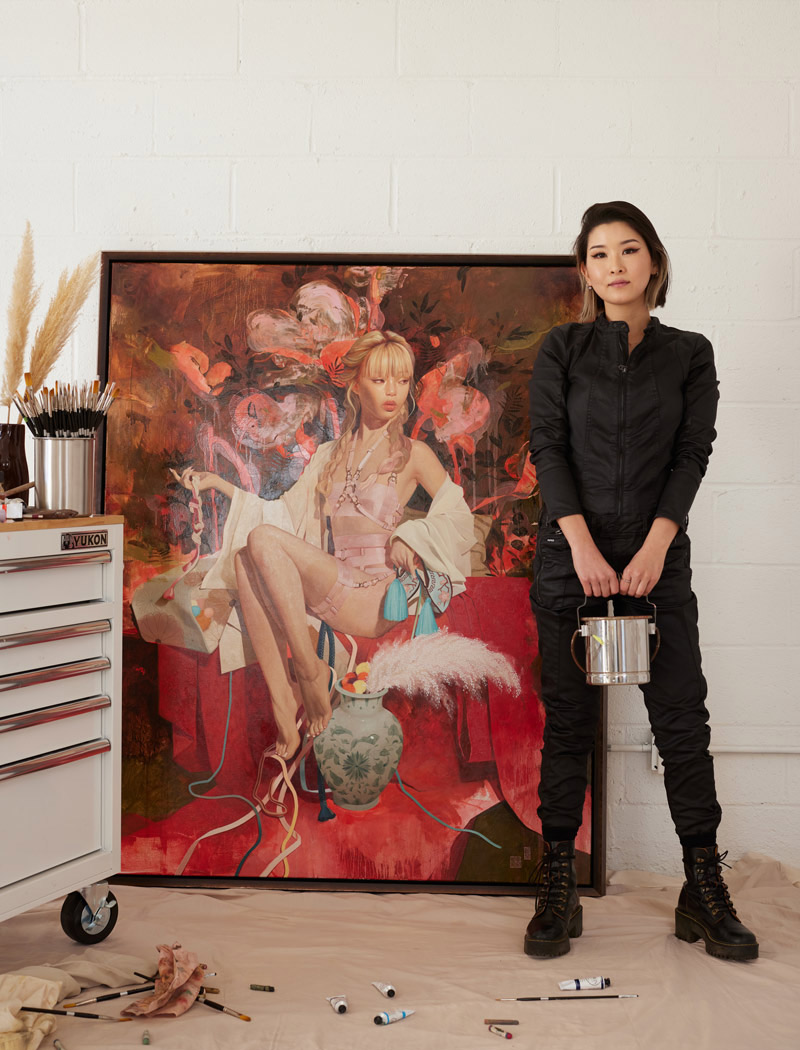Lettera Amorosa | Group Exhibition
Opening, 5pm - 7pm Friday, March 28 - April 19
Lettera Amorosa Love, in all its infinite forms, unfolds in Lettera Amorosa, an evocative exhibition that invites artists to explore the depths of passion, longing, beauty, and loss through the intimate format of the fan fold book. Drawing inspiration from the poetic words of Monteverde, this collection transforms the zigzagged pages into a canvas for boundless creativity, where each fold holds a story, a confession, or a whispered secret. From painting and photography to mixed media and sculpture, the exhibition is a visual love letter—an exploration of how love shapes us, moves us, and lingers in our lives. Lettera Amorosa is more than an exhibition; it is an intimate exchange between artist and audience, where imagery and emotion blur the lines between art and poetry, between longing and fulfillment.

EVOKATION | art + culture + inspiration | July 2024 issue
Be aware in the present. Notice the magic and beauty of the moment. These are Jeremy Miranda’s painting mantras. Miranda finds in daily life unlimited inspiration for his paintings. The works he exhibits in Evoke’s Summer Salon are interior environments and exterior scenes close to home.
“I’m finding beauty in everything,” says Miranda, whose latest pieces include images of a pot of boiling water and a simple wooden table with two chairs. Miranda never travels far from home to find his subjects. Instead, he portrays interior and exterior scenes within a five-mile radius of his studio. “I couldn’t paint a place I visit,” he says. “I need to feel a connection to a place. When I do, I start to see the whole universe there. Then I can drift into a kind of cosmic existence when I paint.”
Other artists in the Summer Salon Part lI exhibit include David T. Alexander, Christopher Benson, Lynn Boggess, Esha Chiocchio, Jeremy Mann, Javier Marín, Louisa McElwain, Soey Milk, Kristine Poole, Lee Price, Michael Scott, Andrew Shears, Thomas Vigil, and Aron Wiesenfeld.
read past issues ►
Gallery Info
Gallery hours are: Tuesday through Saturday, 10 - 5.
You may reach us via Email and 505.995.9902 telephone messaging daily 10 - 5.
Thank you for your continued support.
LOOKING & SEEING
one long look at one work of art . . . or two or three
featuring Moon Baby Blue, Remember When You Fall Asleep, and White in Shade
by Soey Milk
John O'Hern is an arts writer, curator and retired museum director who is providing a weekly contemplation of a single work of art from our gallery. In our fast-paced lives overflowing with information, we find it necessary and satisfying to slow down and take time to look. We hope you enjoy this perspective from John.
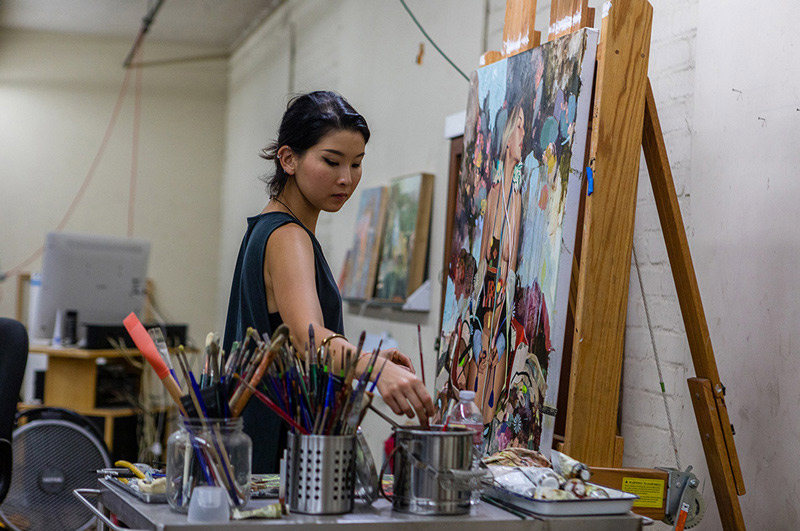 When we began this series, we tried to have “one long look at one work of art.” I’ve veered off the path fairly often, taking the path less traveled by. I used to think an artist’s portfolio should be consistent. Perhaps it was Emerson who broke me of that. In his essay “Self-Reliance” he wrote, “A foolish consistency is the hobgoblin of little minds, adored by little statesmen and philosophers and divines. With consistency, a great soul has simply nothing to do.”
When we began this series, we tried to have “one long look at one work of art.” I’ve veered off the path fairly often, taking the path less traveled by. I used to think an artist’s portfolio should be consistent. Perhaps it was Emerson who broke me of that. In his essay “Self-Reliance” he wrote, “A foolish consistency is the hobgoblin of little minds, adored by little statesmen and philosophers and divines. With consistency, a great soul has simply nothing to do.”
Today, I’m looking at three works by Soey Milk –two oil paintings and a graphite drawing. At first glance they appear to be by different artists, but they have a subtle, grounded consistency that embodies her connection to the world around her, her exploration of the media she uses and her relationship to the people in her life—the activities of a great soul. About her drawings, she writes, “I strive to capture the essence of the subject in front of me, translating its flesh and energy onto paper.”
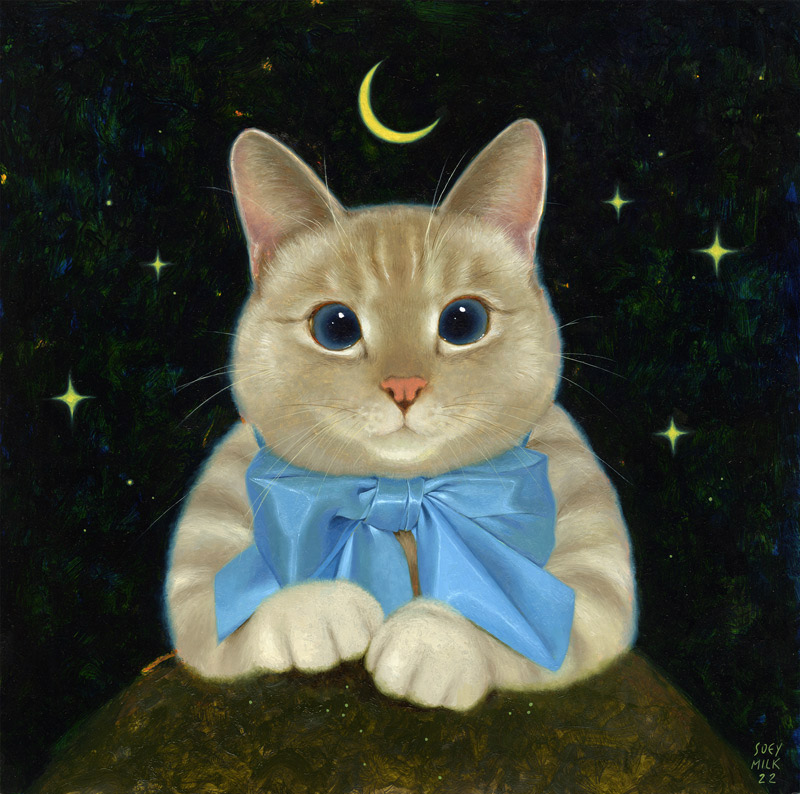 At first glance, Moon Baby Blue, has to be by another artist than the one known for her sensuous figures in complex, painterly settings. Her meticulously-rendered cat with its luminous blue bow gazes out from a star-filled sky that seems, at first, to be a solid color but reveals many colors and texture on closer examination and begins to suggest that the artist is the same.
At first glance, Moon Baby Blue, has to be by another artist than the one known for her sensuous figures in complex, painterly settings. Her meticulously-rendered cat with its luminous blue bow gazes out from a star-filled sky that seems, at first, to be a solid color but reveals many colors and texture on closer examination and begins to suggest that the artist is the same.
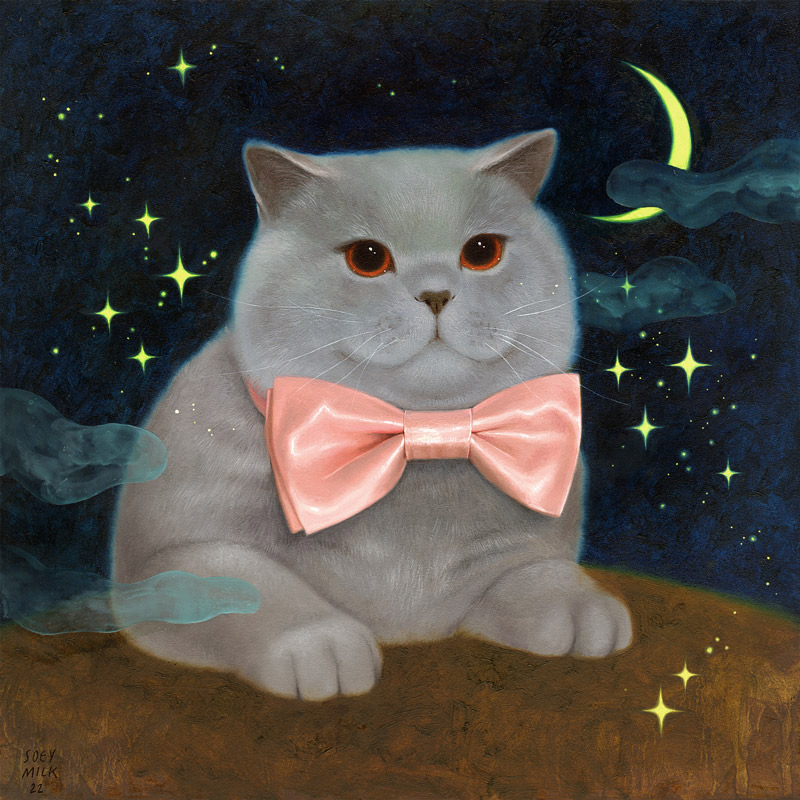 Soey comments, “The Moon Baby Blue (and Moon Baby Pink) indeed marks a departure from my usual figurative work. This piece combines intricate realism with a lighter, more whimsical touch. Each strand and fuzz of the cat’s fur is carefully rendered to create a lifelike texture, while its glowing eyes add a captivating element. The backdrop, a serene yet playful night sky, gives the piece a soft charm. The balance between the highly detailed subject and the more stylized atmosphere brings a unique harmony that feels both engaging and soothing. It offers a fresh perspective, blending technical precision with an unexpected sense of warmth and wonder.”
Soey comments, “The Moon Baby Blue (and Moon Baby Pink) indeed marks a departure from my usual figurative work. This piece combines intricate realism with a lighter, more whimsical touch. Each strand and fuzz of the cat’s fur is carefully rendered to create a lifelike texture, while its glowing eyes add a captivating element. The backdrop, a serene yet playful night sky, gives the piece a soft charm. The balance between the highly detailed subject and the more stylized atmosphere brings a unique harmony that feels both engaging and soothing. It offers a fresh perspective, blending technical precision with an unexpected sense of warmth and wonder.”
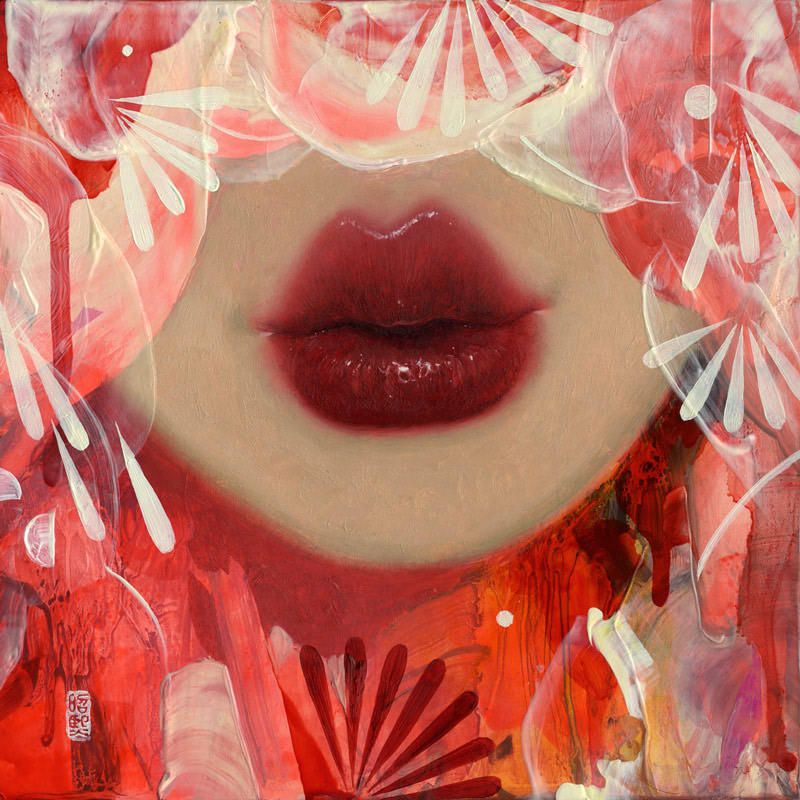 Remember When You Fall Asleep No. 3 is immediately recognizable as a Soey Milk painting with the lips resembling the glaze on a fruit tart and the surrounding, flatly-painted, simplified flower blossoms.
Remember When You Fall Asleep No. 3 is immediately recognizable as a Soey Milk painting with the lips resembling the glaze on a fruit tart and the surrounding, flatly-painted, simplified flower blossoms.
She explains, “As for the 6" x 6" piece of ruby-red lips, it’s a study in both precision and symbolism. The lips are rendered in much detail, capturing the glossy, wet texture with subtle pink, red, and petal tones that give it a sensual depth. Surrounding the lips is a mandala-like pattern of flower petals, a recurring motif in my work. These petals aren’t simply decorative; they represent a deeper meaning. The center signifies the self, while the petals extending outward symbolize energy and connection.”
 Soey’s drawings are “at the heart of my artistic practice,” she says, “acting as both a blueprint and an emotional exploration of the human experience. I strive to capture the essence of the subject in front of me, translating its flesh and energy onto paper. The act of drawing is deeply personal—each line is not just about precision, but about a connection that evolves through my own human lens. It’s a process that often involves steps back, but always moves forward, steadily refining the work to reveal the soul of the image.”
Soey’s drawings are “at the heart of my artistic practice,” she says, “acting as both a blueprint and an emotional exploration of the human experience. I strive to capture the essence of the subject in front of me, translating its flesh and energy onto paper. The act of drawing is deeply personal—each line is not just about precision, but about a connection that evolves through my own human lens. It’s a process that often involves steps back, but always moves forward, steadily refining the work to reveal the soul of the image.”
Her drawings recall the drawings of Ingres—wonderfully controlled mark making and areas that appear to have appeared by magic.
In White in Shade, a black cord is draped across the figure, a motif that often appears in her paintings. She explains, “The props I incorporate, particularly the silk ropes and cords, go beyond simple compositional tools. They carry a deeper meaning, symbolizing life and relationships. Just as ropes intertwine, stretch, or knot, so do the connections between people. They fuse, unravel, or shift, but always leave their mark. These ropes reflect the strands of life and the ways in which we come together, change, or evolve. As I navigate my own journey, my work becomes a visual timeline—a way to reflect on the relationships and experiences that shape me.
“For those who engage with my art, these recurring motifs—ropes and connections—offer a window into a deeper narrative. Each piece not only represents the figure before me, but also tells a story of relationships, growth, and the marks we leave on one another" . . .
